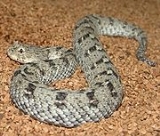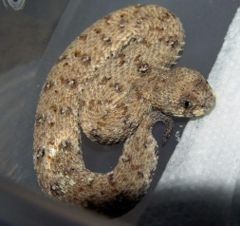
Bitis schneideri
Encyclopedia
- Common names: Namaqua dwarf adder, spotted dwarf adder, Schneider's adder.
Bitis schneideri is a venomous
Venomous snake
"Poisonous snake" redirects here. For true poisonous snakes, see Rhabdophis.Venomous snakes are snakes which have venom glands and specialized teeth for the injection of venom...
viper
Viperinae
The Viperinae, or viperines, are a subfamily of venomous vipers found in Europe, Asia and Africa. They are distinguished by their lack of the heat-sensing pit organs that characterize their sister group, the Crotalinae. Currently, 12 genera and 66 species are recognized...
species
Species
In biology, a species is one of the basic units of biological classification and a taxonomic rank. A species is often defined as a group of organisms capable of interbreeding and producing fertile offspring. While in many cases this definition is adequate, more precise or differing measures are...
found in a small coastal region that straddles the border between Namibia
Namibia
Namibia, officially the Republic of Namibia , is a country in southern Africa whose western border is the Atlantic Ocean. It shares land borders with Angola and Zambia to the north, Botswana to the east and South Africa to the south and east. It gained independence from South Africa on 21 March...
and South Africa
South Africa
The Republic of South Africa is a country in southern Africa. Located at the southern tip of Africa, it is divided into nine provinces, with of coastline on the Atlantic and Indian oceans...
. This is the smallest species in the genus Bitis and possibly the world's smallest viperid
Viperidae
The Viperidae are a family of venomous snakes found all over the world, except in Antarctica, Australia, Ireland, Madagascar, Hawaii, various other isolated islands, and above the Arctic Circle. All have relatively long, hinged fangs that permit deep penetration and injection of venom. Four...
. No subspecies are currently recognized.
Description

Bitis
Bitis is a genus of venomous vipers found in Africa and the southern Arabian Peninsula. It includes the largest and the smallest vipers in the world. Members are known for their characteristic threat displays that involves inflating and deflating their bodies while hissing and puffing loudly. The...
and possibly the world's smallest viperid
Viperidae
The Viperidae are a family of venomous snakes found all over the world, except in Antarctica, Australia, Ireland, Madagascar, Hawaii, various other isolated islands, and above the Arctic Circle. All have relatively long, hinged fangs that permit deep penetration and injection of venom. Four...
.
Geographic range
White coastal sand dunes from Namibia, near Lüderitz, south to Hondeklip Bay, Little NamaqualandNamaqualand
Namaqualand is an arid region of Namibia and South Africa, extending along the west coast over and covering a total area of 170,000 square miles/440,000 km². It is divided by the lower course of the Orange River into two portions - Little Namaqualand to the south and Great Namaqualand to the...
, South Africa
South Africa
The Republic of South Africa is a country in southern Africa. Located at the southern tip of Africa, it is divided into nine provinces, with of coastline on the Atlantic and Indian oceans...
. The type-locality given is "Angra Pequenia" [Lüderitz Bay, Namibia]. Mallow et al. (2003) describe the range as the transitional regions of the Namib Desert
Namib Desert
The Namib Desert is a desert in Namibia and southwest Angola that forms part of the Namib-Naukluft National Park, the largest game reserve in Africa. The name "Namib" is of Nama origin and means "vast place"...
. The range may extend up to 60 km inland in the Sperrgebeit of southern Namibia.
Conservation status
This species is classified as vulnerable (VU) on the IUCN Red List for the following criteria: A2cd (v2.3, 1994). This means that a population reduction of at least 20% is projected or suspected to be met within the next ten years or three generations, whichever is the longer, due to a decline in area of occupancy, extent of occurrence and/or quality of habitat, or due to actual or potential levels of exploitation. Year assessed: 1996.Venom
An account is provided by Hurrell (1981) of a bite he sustained on his left index finger. The symptoms included intense pain, pronounced swelling, discoloration and oozing of serum from the punctures. After 24 hours, a 5 mm hematoma developed at the bite site. His condition stabilized after 3–4 days with swelling and pain gradually subsiding. Healing was complete after 2 weeks with no loss of function or sensation of the afflicted digit. There was minimal local tissue damage and no systemic effects were reported. No antivenom is available for this species.External links
- Namaqua dwarf adder (Bitis schneideri) at ARKive. Accessed 5 October 2006.

